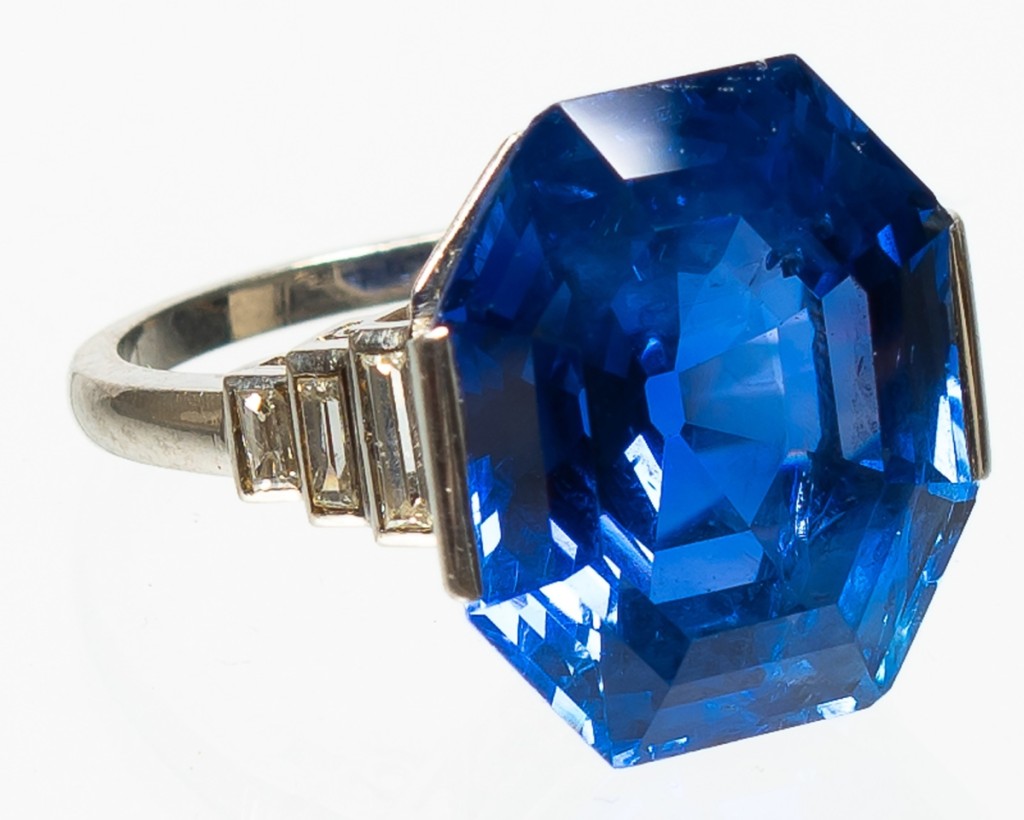
The Art Deco platinum Burmese sapphire ring with diamonds was expected to be the star of the sale. It did not disappoint, selling for $156,000 to a phone bidder who also bought other pieces from the same collection.
Review and Onsite Photos by Rick Russack, Catalog Photos Courtesy The Cobbs
PETERBOROUGH, N.H. – On July 13, The Cobbs presented a sale that included several tall case and banjo-style clocks, a selection of ethnographic pieces from Northwest Indian tribes and Polynesia, Indian peace medals, Audubon prints, Oriental rugs, folk art, paintings by well-known American artists, early American furniture and fine jewelry. The jewelry selection was excellent and several of the day’s highest prices were in that category, including the top selling lot of the day, a Burmese platinum and sapphire ring.
The platinum ring was an Art Deco-period piece with a 19- to 20-carat deep blue Burmese sapphire, set with diamonds. It was GIA certified as having no indications of heating and stating that it came from Burma (now known as Myanmar). The unmarked platinum setting had stepped baguette diamonds around the sapphire, and it went to a phone bidder who also bought other pieces of jewelry. Prior to the sale, Molly Williams, who manages Cobb’s jewelry department was asked which item had drawn the most presale interest and which item she liked best. “Easy. My favorite is the sapphire ring and it’s probably going to exceed our $80,000 to $100,000 estimate.” She was right. It finished at $156,000.
Williams was smiling after the ring was knocked down and several of the other pieces sold at prices that exceeded their estimates. A platinum diamond ring from the same collection, with three emerald cut diamonds in an Art Deco setting, sold for $10,800 and an eight-piece lot of men’s cufflinks with a total of ten square cut diamonds, reached $13,200, going to the same phone bidder who had purchased the sapphire ring. Passed at the sale was an Art Deco diamond and platinum bracelet, in an elaborate setting with alternating links and round and baguette diamonds. It had the second highest estimate, $30/50,000, and was sold the day after the auction. Cobb requires that high-end jewelry be paid for only by wire transfer.
Williams attended the New Hampshire Institute of Art with the expectation of becoming a goldsmith. She gravitated towards other jewelry and studied as much as she could. She has worked for The Cobbs for three and a half years and enjoys the “hands-on” experience of dealing with consignors and buyers. She provided additional information on the Art Deco jewelry collection, much of which had been assembled while its owner, who was born in France and married into a Chinese family, lived in Paris and China and worked as an artist. When China’s Cultural Revolution started in 1966, the government had begun seizing assets of private citizens and this collection was taken out of the country at that time.
Shortly after the sale began, some of the many clocks were offered. An internet bidder paid $9,600 for a circa 1850 Forestville Mfg., Co., acorn-style shelf clock with a detached fusee movement. The dial was signed and the transfer print in the lower tablet depicted the Merchant’s Exchange, Philadelphia. A tall case clock signed William Morris, Bridgeton, N.J., had a painted iron dial, a time and strike brass movement with calendar dial, seconds dial and moon phase movement. In a mahogany case, it doubled its estimate, finishing at $8,400. The clock is pictured in William E. Drost’s Clocks and Watches of New Jersey. The clock selection included four Simon Willard patent banjo clocks. The one bidders liked best had a “T” bridge brass movement, with two seemingly original reverse painted tablets, one including the Willard inscription, which sold for $3,360. There were more than nine other early American clocks. Sold along with the clocks were two early English stick barometers, which seemed to be among the bargains of the day. One, with a signed bone dial marked “A. Abraham Liverpool” and a side thermometer, was made of cross-banded mahogany, and the other, with two thermometers, was signed on the dial “Robson, New Castle.” Both appeared to be working, but brought only $180.
Results were mixed with the tribal offerings. A Nineteenth Century “Tongan” carved club measuring 26ý inches long, inlaid with whale ivory sun, moon and star, in fine condition, brought $7,800. A brightly painted open-mouth Haida head, with human hair, red, blue and black paint and a finger like extension, dating to the late Nineteenth or early Twentieth Century, earned $6,000, while a Yupik carved and painted dance mask in the form of a fox head from the same time period sold for $2,040. It had large red ears and dry blue-gray paint with red highlights. Some of the ethnographic pieces with higher estimates were passed but sold in the days after the sale. There were about a half dozen circa 1900 Navajo scatter rugs, one of which, with a double medallion on a tan ground, more than tripled its estimate, finishing at $1,140.
A selection of American paintings was included and bringing one of the higher prices of the day, $39,600, was a colorful landscape titled “Orange Dusk” by Wolf Kahn (b 1927). A watercolor by Ogden Minton Pleissner (1905-1983), titled on the reverse “The Beach at Boca Grande,” sold for $4,800, well exceeding the estimate. There were ten tonalist landscapes by William C. Emerson (1865-1937). Most were unsigned but had descended in the family of the artist and generally sold in the $200 to $400 range.
A few days after the sale, Charlie Cobb said that while some American furniture was disappointing, French furniture did well and he said that he was pleasantly surprised with the interest in good Oriental rugs. “And jewelry, of course, made the day. So, it ended up okay for us. We’re looking ahead and have some good sales coming up. We have a good collection of Native American things that we’ll be selling in October and we’re going to do an online only sale of toys and dolls. It looks like 2019 will be a good year. The market for American furniture is hard to believe. What a time to buy! Spending time with potential consignors of American furniture before they decide to sell is essential for us now and probably every other auctioneer. We have to make them understand what most likely will happen.”
The Cobbs website states its approach to the business: “We strive to instill and promote a sense of stewardship and passion for art, antiques and cultural objects. Like many of our customers, we share a belief that objects have meaning and value above and beyond their investment.” The Cobbs is family run and has been in business in Peterborough for more than 40 years. For the last 20 years, the business’s home has been the historic 1875 Noone Falls Mill building, which is owned by The Cobbs. It is a large brick mill with the still active waterfall that once powered the mill machinery. Cobb has restored the building and recently created several condominium apartments.
All prices quoted include buyer’s premium as reported by the auction house. For additional information, 603-924-6361 or www.thecobbs.com.


























